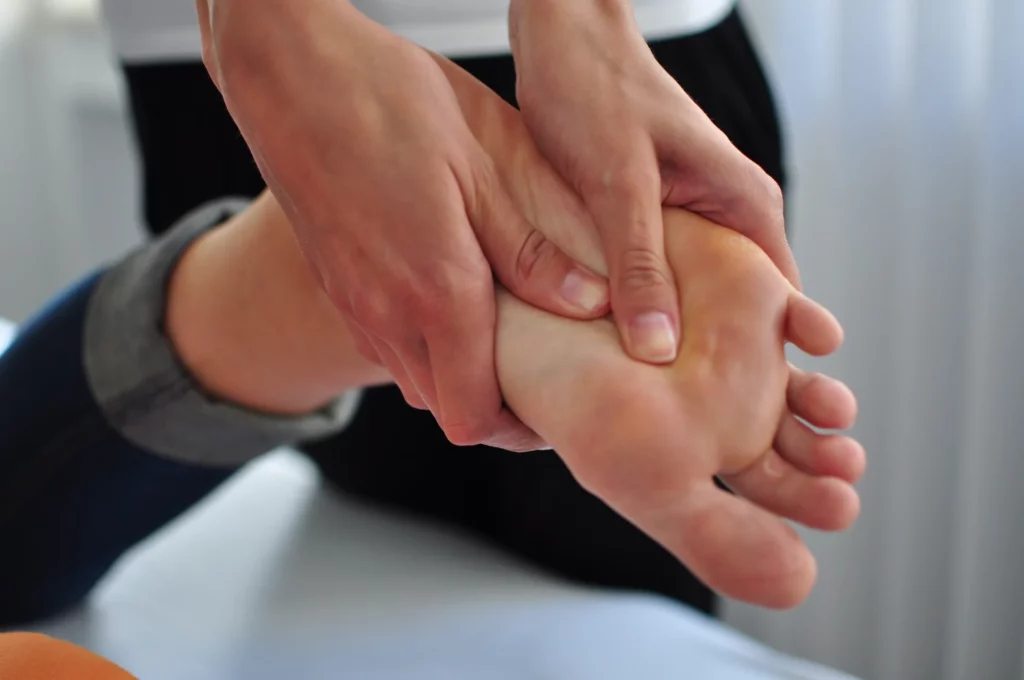How Can We Assist?
When you seek our assistance for foot and ankle discomfort, expect a comprehensive approach to effectively address your pain. The process begins with an initial assessment, gathering information about your medical history, pain duration, and activities that worsen or alleviate the pain.
After the assessment, a physical examination evaluates your foot and ankle’s range of motion, strength, flexibility, and stability, incorporating gait analysis if necessary.
Based on this assessment, a tailored treatment plan is devised. This typically includes manual therapy, muscle-strengthening exercises, Muscle strengthening and Stretching exercises, and modalities such as heat or cold therapy.
Throughout your treatment, we monitor progress and adjust the plan as needed. You receive education on your condition, home exercises, and preventive strategies.
In summary, physiotherapy for foot and ankle discomfort aims to reduce pain, enhance function, and improve your quality of life by addressing underlying causes. Adhering to the recommended plan and maintaining communication with your physiotherapist are vital for the best results.

Ankle and Foot Pain
Common causes of ankle and foot pain that can benefit from physiotherapy include:
- Ankle Sprains: Among the prevalent causes of ankle pain, sprains occur when the ligaments supporting the ankle undergo stretching or tearing. Physiotherapy interventions may encompass exercises to fortify the ankle and enhance balance and stability.
- Plantar Fasciitis: Involving inflammation of the plantar fascia—a robust band of tissue on the underside of the foot. Physiotherapy approaches may encompass stretching exercises, massage, and orthotics to alleviate pain and enhance foot function.
- Achilles Tendonitis: Inflammation of the Achilles tendon can result in pain at the back of the ankle. Physiotherapy may involve exercises targeting calf muscle strength and eccentric loading exercises to facilitate tendon healing.
- Stress Fractures: Overuse or repetitive impact can lead to stress fractures in the foot bones. Physiotherapy focuses on rest, suitable footwear, and a gradual return to activity once the fracture has healed.
- Tendon Injuries: Injuries to foot and ankle tendons, like peroneal or tibialis posterior tendon injuries, can cause pain and instability. Physiotherapy may include exercises to fortify these tendons and enhance their function.
- Bunions: A bony bump forming at the base of the big toe. Physiotherapy aids in pain management through exercises, recommendations for footwear, and orthotic devices.
- Post-Surgical Rehabilitation: Following foot or ankle surgery, such as ankle reconstruction or bunion surgery, physiotherapy is essential for regaining strength, mobility, and function.
- Shin Splints: Pain along the front or inside of the shin due to overuse or improper biomechanics. Physiotherapy may involve gait analysis, orthotic recommendations, and exercises addressing underlying issues.
- Flat Feet (Pes Planus): Physiotherapists can suggest exercises to strengthen the arch muscles of the foot and recommend orthotics for support and pain relief.
- Arthritis: Osteoarthritis and rheumatoid arthritis affecting foot and ankle joints. Physiotherapy aims to enhance joint mobility, alleviate pain, and strengthen surrounding muscles.
- Tarsal Tunnel Syndrome: Similar to carpal tunnel syndrome but involving nerve compression in the ankle. Physiotherapy interventions may include exercises and modalities to reduce nerve irritation.
Consulting with a physiotherapist or healthcare professional is crucial to accurately diagnose the cause of ankle or foot pain and develop a personalised treatment plan. The specific physiotherapy techniques and exercises recommended will depend on the underlying condition and individual factors.
See What Our Patients Have To Say
Trustindex verifies that the original source of the review is Google. Very detailed assessment of symptoms, extensive examination and precise treatment plan made. Treatment successfulTrustindex verifies that the original source of the review is Google. Danielle is good at listening to the problem is careful and thorough in investigating and gives clear advice and explanation of exercises. Also friendly!Trustindex verifies that the original source of the review is Google. Danielle was recommended by a relative to fix a shoulder injury. Within just a few appointments the pain alleviated and the whilst the injury was restrictive, the following appointments did a lot to regain movement and alleviate discomfort. A susequent procedure by Shona did much to fix the underlying problem and continued physio by Danielle is putting things well on the road to recovery. Can't recommend the clinic highly enough.Trustindex verifies that the original source of the review is Google. Have had a few appointments with Danielle and have been pain free for the first time in a while! Excellent service and very happy to help!Trustindex verifies that the original source of the review is Google. Anytime I start to feel my back pain returning or have a fresh injury my first stop is to book an appointment with Shona. She is extraordinary at what she does. It is hard to find such a good physio!Trustindex verifies that the original source of the review is Google. Really helpful series of appointments identifying the exercises which built up both balance and strength in glutesTrustindex verifies that the original source of the review is Google. I am a an older horse rider so go regularly to get top up help very professional but friendly and I always feel more comfortable after definitely recommendTrustindex verifies that the original source of the review is Google. Great place and welcoming staff who take time to explain issues and treatment. My lower back has come on tremendously since my treatment.Trustindex verifies that the original source of the review is Google. I have had a number of running related injuries this year and Danielle and Shona have have got me back on my feet with a combination of acupuncture and specific exercises. The treatment has been first class and also realistic (they know I want to get back running asap!). They are professional, friendly, and highly competent. Highly recommended.Trustindex verifies that the original source of the review is Google. Great place, friendly and know what they are doing!